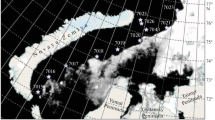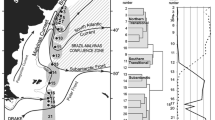Abstract
Size-fractionated primary production was measured by carbon-14 uptake incubations on three transects between 47°S and 59°30′S along 6°W in October/November 1992. Open Antarctic Circumpolar Current and ice-covered Weddell Gyre water showed comparable low productivity (∼0.3 gCm−2 day−1) and size distribution. Picoplankton (<2 μm) was the dominant size fraction, contributing approximately half to the total water column production. The significance of larger (>20 μm) phytoplankton was only minor. Productivity in the Polar Front Zone north of 50°S, with higher water column stability, was up to 10 times higher with microplankton (>20 μm) being predominant. No ice-edge bloom occurred over the 2 months study period; this is explained by non-favourable hydrographic conditions for blooming and the lack of melt-water lenses upon ice retreat. Picoplankton tended to make higher contributions at lower water column stability, and microplankton to make higher contributions at higher stability. Mixing, together with light climate, are discussed as the driving forces for Antarctic primary production and for its size structure.
Similar content being viewed by others
References
Andreoli C, Scarabel LR, Tolomio C (1993) Distribution du picoplankton photoautotrophe dans la baie de Terra Nova (Mer de Ross, Antarctique) pendent l'été austral 1989–1990. Algol Stud 68:123–132
Azam F, Smith DC, Hollibaugh JT (1991) The role of the microbial loop in Antarctic pelagic ecosystems. Polar Res 10:239–243
Becquevort S, Mathot S, Lancelot C (1992) Interactions in the microbial community of the marginal ice zone of the northwestern Weddell Sea through size distribution analysis. Polar Biol 12:211–218
Bianchi F, Boldrin A, Coice F, Dieckmann G, Kuosa H, Larsson AM, Nöthig EM, Sehlstedt PL, Socal G, Syvertsen EE (1992) Phytoplankton distribution in relation to sea ice, hydrography and nutrients in the northwestern Weddell Sea in early spring 1988 during EPOS. Polar Biol 12:225–235
Bodungen B von (1986) Phytoplankton growth and krill grazing during spring in the Bransfield Strait, Antarctica — implications from sediment trap collections. Polar Biol 6:153–160
Brand LE (1991) Minimum iron requirements of marine phytoplankton and the implication for the biogeochemical control of new production. Limnol Oceanogr 36:1756–1771
Bröckel K von (1981) The importance of nanoplankton within the pelagic Antarctic ecosystem. Kiel Meeresforsch [special issue] 5:61–67
Buma AGJ, Tréguer P, Kraay CW, Morvan J (1990) Algal pigment patterns in different water masses of the Atlantic sector of the Southern Ocean during fall 1987. Polar Biol 11:55–62
Buma AGJ, Gieskes WWC, Thomsen HA (1992) Abundance of Cryptophyceae and chlorophyll b containing organisms in the Weddell Sea Scotia Confluence area in the spring of 1988. Polar Biol 12:45–52
Buma AGJ, Noordeloos AAM, Larsen J (1993) Strategies and kinetics of photoacclimation in three Antarctic nanophyto-flagellates. J Phycol 29:407–417
Chisholm SW (1992) Phytoplankton Size. In:Falkowski PG, Woodhead AD (eds) Primary production and biogeochemical cycles in the sea. Plenum press, New York, pp 213–237
Comiso JC (1991) Satellite remote sensing of polar oceans. J Mar Systems 2:395–434
Comiso JC, McClain CR, Sullivan CW, Ryan JP, Leonard CL (1993) Coastal Zone Color Scanner pigment concentrations in the Southern Ocean and relationships to geophysical surface features. J Geophys Res 98-C2:2419–2451
Cota GF, Kottmeier ST, Robinson DH, Smith WO, Sullivan CW (1990) Bacterioplankton in the marginal ice zone of the Weddell Sea:biomass, production and metabolic activities during austral autumn. Deep-Sea Res 37:1145–1167
DiTullio GR, Hutchins DA, Bruland KW (1993) Interaction of iron and major nutrients controls phytoplankton growth and species composition in the tropical North Pacific Ocean. Limnol Oceanogr 38:495–508
Eppley RW, Sloan PR (1966) Growth rates of marine phytoplankton:correlation with light absorption by cell chlorophyll a. Physiol Plant 19:47
Fiala M, Delille D (1992) Variability and interactions of phytoplankton and bacterioplankton in the Antarctic neritic area. Mar Ecol Prog Ser 89:135–146
Garrison DL (1991) An overview of the abundance and role of protozooplankton in Antarctic waters. J Mar Systems 2:317–331
Garrison DL, Buck KR (1989) Protozooplankton in the Weddell Sea, Antarctica:abundance and distribution in the ice edge zone. Polar Biol 9:341–351
Hewes CD, Sakshaug E, Reid FMH, Holm-Hansen O (1990) Microbial autotrophic and heterotrophic eucaryotes in Antarctic waters:relationships between biomass and chlorophyll, adenosine triphosphate and particulate organic carbon. Mar Ecol Prog Ser 63:27–35
Jacques G, Panouse M (1991) Biomass and composition of size fractionated phytoplankton in the Weddell-Scotia Confluence area. Polar Biol 11:315–328
Jong JTM de, Löscher BM, Baar HJW de (1994) Iron in surface waters and sea-ice in the Antarctic Circumpolar Current. EOS Transcr Am Geophys Union 75:178
Langdon C (1988) On the causes of interspecific differences in the growth-irradiance relationship for phytoplankton, II: general review. J Plankton Res 10:1291–1312
Laubscher RK, Perissinotto R, McQuaid CD (1993) Phytoplankton production and biomass at frontal zones in the Atlantic sector of the Southern Ocean. Polar Biol 13:471–481
Legendre L, Demers S, Yentsch CM, Yentsch CS (1983) The 14C method:patterns of dark CO2 fixation and DCMU correction to replace the dark bottle. Limnol Oceanogr 28:996–1003
Martin JH, Gordon RM, Fitzwater SE (1990) Iron in Antarctic waters. Nature 345:156–158
Mathot S, Dandois JM, Lancelot C (1992) Gross and net primary production in the Scotia-Weddell Sea sector of the Southern Ocean during spring 1988. Polar Biol 12:321–332
Mitchell BG, Holm-Hansen O (1991) Observation and modelling of the Antarctic phytoplankton crop in relation to mixing depth. Deep-Sea Res 38:981–1007
Morel A, Bricaud A (1981) Theoretical results concerning light absorption in a discrete medium and application to specific absorption of phytoplankton. Deep-Sea Res 28:1375–1393
Morel FMM, Hudson RJM, Price NM (1991) Limitation of productivity by trace metals in the sea. Limnol Oceanogr 36:1742–1755
Raimbault P, Rodier M, Taupier-Letage I (1988) Size fractionation of phytoplankton in the Ligurian Sea and the Algerian Basin (Mediterranean Sea): Size distribution versus total concentration. Mar Microb Food Webs 3:1–7
Sakshaug E, Slagstad D, Holm-Hansen O (1991) Factors controlling the development of phytoplankton blooms in the Antarctic Ocean — a mathematical model. Mar Chem 35:259–271
Schlesinger DA, Molot LA, Shuter BJ (1981) Specific growth rates of freshwater algae in relation to cell size and light intensity. Can J Fish Aquat Sci 38:1052–1058
Sieburth J.McN, Smetacek V, Lenz J (1978) Pelagic ecosystem structure:Heterotrophic compartments of the plankton and their relationship to plankton size fractions. Limnol Oceanogr 23:1256–1263
Smetacek V, Passow U (1990) Spring bloom initiation and Sverdrup's critical depth model. Limnol Oceanogr 35:228–234
Smetacek V, Scharek R, Nöthig EM (1990) Seasonal and regional variation in the pelagial and its relationship to the lift history cycle of krill. In:Kerry KR, Hempel G (eds) Antarctic ecosystems: ecological change and conservation. Springer, Berlin Heidelberg New York, pp 103–114
Smith WO Jr, Nelson DM (1985) Phytoplankton bloom produced by a receding ice edge in the Ross Sea: spatial coherence with the density field. Science 227:163–166
Smith WO, Keene NK, Comiso JC (1988) Interannual variability in estimated primary productivity of the Antarctic marginal ice zone. In:Sarhage D (ed) Antarctic Ocean and resources variability. Springer Berlin Heidelberg New York, pp 132–139
Sommer U (1989) Maximal growth rates of Antarctic phytoplankton: only weak dependence on cell size. Limnol Oceanogr 34:1109–1112
Sullivan CW, McClain CR, Comiso JC, Smith WO (1988) Phytoplstanding crops within Antarctic ice edge assessed by satellite remote sensing. J Geophys Res 93:487–498
Sunda WG, Swift DG, Huntsman SA (1991) Iron growth requirements in oceanic and coastal phytoplankton. Nature 351:55–57
Sverdrup HU (1953) On conditions for the vernal blooming of phytoplankton. J Cons Perm Int Explor Mer 18:287–294
Veth C, Peeken I, Scharek R (1994) Physical anatomy of fronts and surface waters in the ACC near the 6°W meridian during austral spring 1992. Deep-Sea Res (in press)
Weber LH, El-Sayed SZ (1987) Contributions of the net, nanoand picoplankton to the phytoplankton standing crop and primary productivity in the Southern Ocean. J Plankton Res 9:973–994
Author information
Authors and Affiliations
Rights and permissions
About this article
Cite this article
Jochem, F.J., Mathot, S. & Quéguiner, B. Size-fractionated primary production in the open Southern Ocean in austral spring. Polar Biol 15, 381–392 (1995). https://doi.org/10.1007/BF00239714
Received:
Accepted:
Issue Date:
DOI: https://doi.org/10.1007/BF00239714




